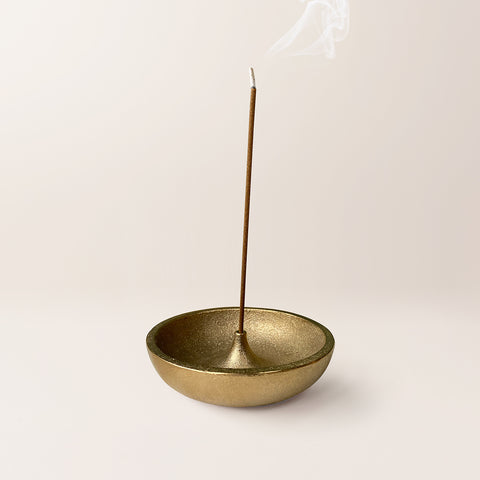Early use of incense in Japan
Incense has long evoked images of ritualism, worship, and spirituality all over the world. Although the origins of incense have been traced to ancient Egypt, the earliest documented use was in China, from where incense made its way into Japan in 595 AD under the reign of Empress Suiko. The import of incense paralleled with the introduction of Buddhism to Japan, and fragrant woods like agarwood and sandalwood were burned with herbs to create a sacred atmosphere for Buddhist temple rituals. By the Nara period (between 710–784 AD), the Imperial Court took inspiration from the temples and began to light incense for personal use – to perfume their clothes, hair and rooms. Not only was incense used to purify courtiers and their environment, but it became a symbol of high culture and refined taste. Recreational use also flourished, and guessing fragrances in “incense games” became a popular pastime with the royalty. Once lit in mounds of raw material in temple settings, incense took on the more elegant stick shape that we know today.
Koh-do “the way of fragrance”
During the Muromachi era (between 1336 to 1573), incense spread from the Imperial Court to the middle and upper classes, and it continued to emerge as a status symbol that marked homes and clothing. Even the samurai class began to adopt special rituals, and they would perfume their armor with incense to cleanse their body, minds, and spirit as preparation for their fates at battle. Koh-do or the “way of incense” developed alongside the sado tea ceremony and other refined arts with formalities, etiquette, and customs. Once confined to only the elite, Koh-do prevailed in the lives of intellectuals such as writers, artists, landowners, and merchants, and they upheld the codes of fragrance appreciation very seriously. Koh-do was said to have ten physical and psychological virtues, including purifying mind and body, improving mental awareness, sharpening meditation, and bringing communication with the transcendent. Intense utensils were also perfected, and the iconic koro or incense holder was considered essential.
Modern use of Japanese incense
Although true koh-do ceremonies are rarely practiced today, incense continues to be a mainstay in Japanese culture for enjoyment and relaxation. Although there are many types of Japanese incense, senko or stick incense is the most convenient and easy to use. Japanese incense holders have also taken on modern styles that retain the aesthetic and simplistic feel of Japan’s distant past. Brass holders like the S/N Incense Holder by Taku Shinomoto have a traditional, clean and minimalist design, while sleek statement-making ones like the Sumitani Saburo Shoten Solid Brass Ball Shaped Incense Holder by artisan Masataka Sumitani can accommodate both long and short stick incense. Sumitani also makes an ultra-modern Brass Cubic Incense Holder that doubles as a paperweight and is bound to jazz up any desk, counter or table.
Whether you want to purify your meditation space or simply just enjoy the scent, incense is an easy way to instantly set the mood, elevate the senses and calm the mind. Especially with new norms of cleanliness and hygiene right now, a personal ritual for purification can help bring a sense of stability and peace of mind in an otherwise uncertain world. With so many different incense varieties, scents, and tools, both first-timers and incense aficionados are bound to find an arrangement that hits the spot.
Sumitani Saburo Shoten / Solid Brass Ball Shaped Incense Holder



